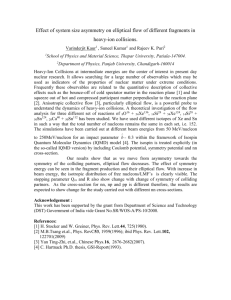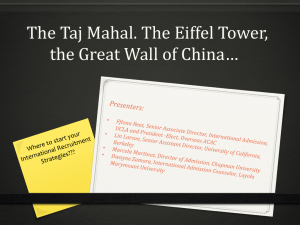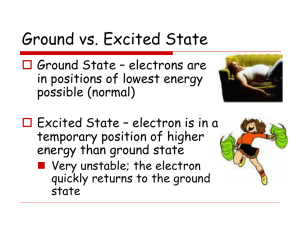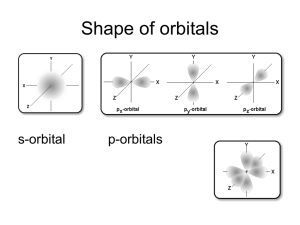Title : Theoretical studies of interactions of atoms, molecules and
advertisement
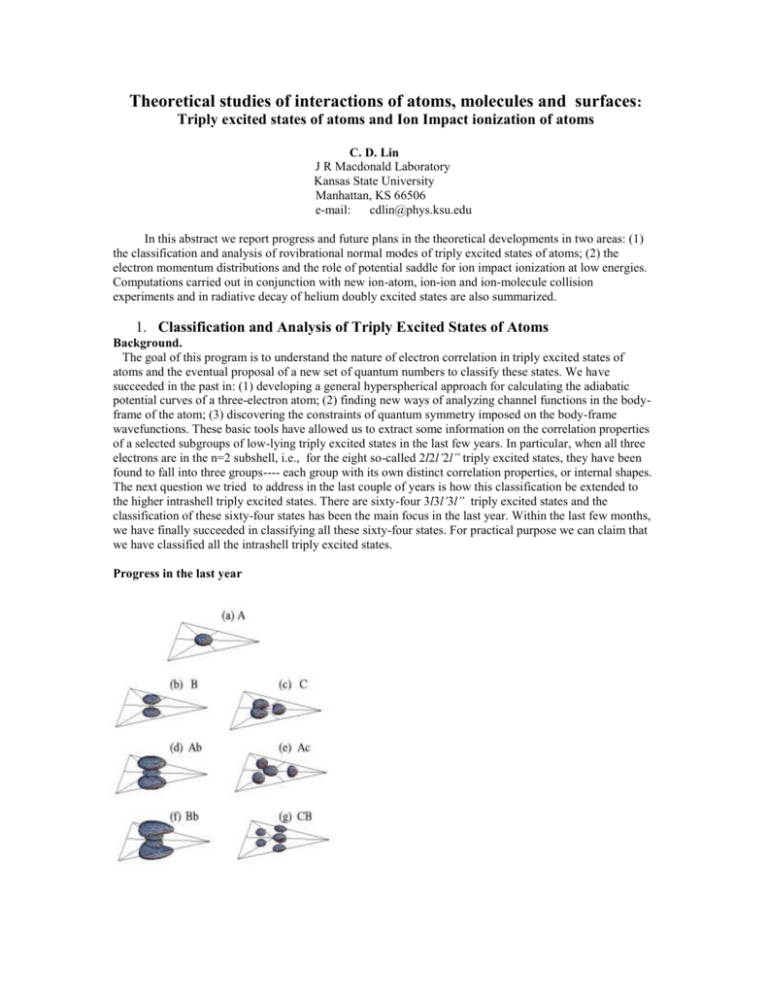
Theoretical studies of interactions of atoms, molecules and surfaces: Triply excited states of atoms and Ion Impact ionization of atoms C. D. Lin J R Macdonald Laboratory Kansas State University Manhattan, KS 66506 e-mail: cdlin@phys.ksu.edu In this abstract we report progress and future plans in the theoretical developments in two areas: (1) the classification and analysis of rovibrational normal modes of triply excited states of atoms; (2) the electron momentum distributions and the role of potential saddle for ion impact ionization at low energies. Computations carried out in conjunction with new ion-atom, ion-ion and ion-molecule collision experiments and in radiative decay of helium doubly excited states are also summarized. 1. Classification and Analysis of Triply Excited States of Atoms Background. The goal of this program is to understand the nature of electron correlation in triply excited states of atoms and the eventual proposal of a new set of quantum numbers to classify these states. We have succeeded in the past in: (1) developing a general hyperspherical approach for calculating the adiabatic potential curves of a three-electron atom; (2) finding new ways of analyzing channel functions in the bodyframe of the atom; (3) discovering the constraints of quantum symmetry imposed on the body-frame wavefunctions. These basic tools have allowed us to extract some information on the correlation properties of a selected subgroups of low-lying triply excited states in the last few years. In particular, when all three electrons are in the n=2 subshell, i.e., for the eight so-called 2l2l’2l” triply excited states, they have been found to fall into three groups---- each group with its own distinct correlation properties, or internal shapes. The next question we tried to address in the last couple of years is how this classification be extended to the higher intrashell triply excited states. There are sixty-four 3l3l’3l” triply excited states and the classification of these sixty-four states has been the main focus in the last year. Within the last few months, we have finally succeeded in classifying all these sixty-four states. For practical purpose we can claim that we have classified all the intrashell triply excited states. Progress in the last year To classify the 3l3l’3l” triply excited states we analyze the wavefunctions of a model atom with the three electrons confined to the surface of a sphere since intrashell states are distinguished by their relative angles with respect to each other. By analyzing the wavefunction in the body-frame where the overall rotational motion can be separated, each state is represented by a body-frame function which has three degrees of freedom. Using contour surfaces we have been able to actually visualize the wavefunctions directly. From the calculated electronic densities we have been able to identify the internal shape of each state. Examples of such contour surfaces are shown on the left without full explanations (see pub. A1 below). First, the groups A, B and C are the elementary normal modes that have been identified previously for the 2l2l’2l” states. However, new modes such as Ab, Ac, Bb and CB which are excited states of these normal modes have been found. The symbol Ab shows that it is a combined mode of A and B. With these excited modes identified we have been able to classify all the 64 3l3l’3l” triply excited states of the model atom into groups of the rotational levels of a symmetric top, and the shape of each symmetric top is “visualized” through the contour surfaces above. After all the sixty-four 3l3l’3l” states of the model atom have been classified, we found that the energy levels of the 64 intrashell 3l3l’3l” triply excited states of N2+ and N4+ calculated by Vaeck and Hansen [ J. Phys. B25, 883 (1992)] can indeed be classified into manifolds of rotational states as in the model atom, proving the validity of the present classification scheme. Future Plan We have found the classification scheme for the 2l2l’2l” and 3l3l’3l” triply excited states. Thus the classification of intrashell triply excited states is basically complete. Our next goal in the immediate future is to classify intershell triply excited states. We are looking at the 2l2l’nl” states with n greater than 2. We need to identify the correlation between the inner pair electrons and the outer electron, and examine the possible normal modes. We need to find out what is the condition that intrashell states can be fit into the Rydberg series. This is the next step for us to reach an eventual full classification scheme for triply excited states of atoms. 2. Mechanism of ion impact ionization of atoms at low energies Background Ion impact ionization of a neutral atom is one of the prototype elementary reactions where the final products involve three charged particles. In analogy to the Wannier mechanism for electron impact ionization of a neutral atom near threshold, the potential saddle is expected to play an important role. Consider proton impact ionization of atomic hydrogen, the electrostatic potential experienced by the electron from the two nuclei has a potential saddle at the midpoint of the internuclear line. For slow collisions, ionization is unlikely except when the electron can straddle the potential ridge as the two nuclei separate, since away from the saddle the electron tends to fall into one of the potential wells, to form bound states in the final product. Over the last two decades there have been a lot of debates on the importance of these so-called saddle point electrons, and more importantly, what is the clear experimental signature of such a mechanism. In the last few years we have embarked a new theoretical approach aiming at calculating the electron momentum distributions of the ejected electrons. We developed a new method of solving the time-dependent Schrodinger equation in momentum space such that the momentum distribution of the ejected electrons can be obtained directly. Progress in the last year We have previously calculated the ejected electron momentum distributions for proton-hydrogen atom collisions and analyzed the role of saddle point mechanism. We concluded that saddle point mechanism is important only for slow collisions. However the -electron type momentum distributions in the perpendicular direction, as well as the peak of longitudinal momentum distributions near the potential saddle were found not a signature of the saddle point mechanism since both occur at low energies as well as at higher impact energies. Our predictions are still waiting for experimental confirmation. To pursue this issue further we examined the He2++ H system in the last year. At high energies, the calculated longitudinal momentum distribution was found to be near the target as expected. As the collision energy is lowered, the distribution is shifted toward the projectile. At further decrease, the distribution then shifts back toward the target. The latter shift is an indication of the importance of the saddle point mechanism for ionization at low energies. (see Pub. B1 below) In the last year we have also performed careful calculations of the total impact ionization cross sections for proton-hydrogen system. In spite of the continuing theoretical and experimental efforts over many decades, the absolute total ionization cross sections for this system still differ by 25-40% in the 15-200 keV region. Our new calculations confirm the results from the largest close-coupling calculations carried out by Toshima. Both differ quite significantly from existing experimental data as well as from other less sophisticated calculations so far. Future Plan The direct solution of the time-dependent Schrodinger equation in momentum space we developed so far has some success. However we have recently realized that there is an intrinsic limitation in describing ionization event in a direct numerical approach. It is not practical to integrate the equation directly to large internuclear distances or for a long time since the numerical method would fail. Following the work of Sidky and Esry, it is found that direct numerical integration in a scaled space would eliminate such problems at large time. The latter method has been tested on one-dimensional problems. [see Report by Esry] In collaboration with Esry, we hope to generalize the scaled space approach to ion-atom collisions in the near future. It is hoped that this would allow us to propagate the time-dependent equation to the long time needed to extract the momentum distributions, so that they can be compared directly with experimental measurements for collisions at low energies. 3. Other topics in ion-atom collisions We continued a number of studies in one- and two-electron processes in ion-atom collisions in conjunction with new experiments. This ranges from single electron capture cross sections to the alignment parameters of proton impact excitation of helium atoms, as well as transfer ionization cross sections at high impact energies. (See Pub. List C below) Works in progress A new effort at the J. R. Macdonald Laboratory in the last year is the so-called Motrim experiments in the group of Brett DePaola. With laser-cooled atoms in a MOT trap and a new low-energy ion source, they have been able to measure accurate state-selective charge transfer cross sections in the low energy regime with much higher precision. They also can perform experiments from the ground state as well as from the excited states at the same time. Together with the angular measurements, they are providing a new set of mutually normalized experimental data that are valuable for testing the theory critically. We are performing new calculations for systems that have been or will be measured. Already we have found that a more precise description of the internuclear potential is needed for reproducing the differential cross sections. 4. Radiative Decay of doubly excited states of He In the last year, in collaboration with M. K. Chen (Chung-Hsin University, Taiwan) we have investigated the radiative vs Auger rates of the doubly excited states of He, in view of new experiments in the last couple of years. The radiative rates of He doubly excited states have been neglected by theorists so far since they are very weak, but these weak channels have been measured recently with the new intense synchrotron light sources. We have also calculated the lifetimes of low-lying doubly excited states of He and shown that the states in the A=0 series decay primarily via radiative processes. [see pub. D1] There is no immediate plan for continuing in this area of work next year. Publications (1998-2001) A.Triply excited states of atoms A1. Toru Morishita and C. D. Lin, " Identification and visualization of the collective normal modes of intrashell triply excited states of atoms", J. phys. B34, L105 (2001). A2. C. D. Lin and Toru Morishita, "Few-body problems: the hyperspherical way", Physics Essays, 13, 367 (2001). A3. C. D. Lin and Toru Morishita, "Visualization of electron correlations in doubly and triply excited states of atoms" Book chapter, Photodetachment and Photoionization, edited by C.Y. Ng, Part II, pp1161-1203. World Scientific, Singapore, 1999. A4. Toru Morishita and C. D. Lin, "Comprehensive analysis of electron correlations in three-electron atoms", Phys. Rev. A59, 1835 (1999). A5. Toru Morishita, Yong Li and C. D. Lin "Visualization of correlations in intrashell triply excited states of atoms", Phys. Rev. A58, 4214 (1998). A6. Toru Morishita and C. D. Lin " Hyperspherical analysis of doubly and triply excited states of Li" Phys. Rev. A57, 4268 (1998). A7. Toru Morishita and C. D. Lin “Analysis of sell' and 2l2l'2l'' resonances of He - ions”, J. Phys. B31, L209 (1998). A8. Toru Morishita, C. D. Lin and C. G. Bao “On the nonexistence of resonances in H 2-“, Phys. Rev. Lett. 80, 464 (1998) B. Ion impact ionization of atoms B1. Emil Sidky, Clara Illescas and C. D. Lin, "The role of potential Saddle in alpha + H impact ionization", J. Phys. B. Lett. B34, L163 (2001) B2. Emil Sikdy, Clara Illescas and C. D. Lin, "Electrons ejected with half the projectil e velocity and the saddle point ionization mechanism", Phys. Rev. Lett. 85, 1634 (2000) B3. E. Sidky and C. D. Lin, "Impact Velocity Dependence of Ejected Electron distributions for ionization in Proton-Hydrogen Collisions", Phys. Rev. A60, 377 (1999) B4. Emil Y Sidky and C D Lin "Quantum Mechanical Calculation of Ejected Electron Spectra for IonAtom Collisions", J. Phys. B31, 2949 (1998). C. Electron capture in ion-atom collisions C1. C. D. Lin and F. Martin, Sow and fast collisions of atoms, ions and molecules, a chapter in Encyclopedia of Scattering, 2001, Academic Press. C2. A. Amaya-Tapia and H. Martínez, R. Hernández-Lamoneda and C. D. Lin, "Charge transfer in H + + Ar collisions from 10 to 150 keV", Phys. Rev. A 62, 052718 (2000). C3. B.B. Dhal, Lokesh C. Tribedi, U. Tiwari, P.N. Tandon, T. G. Lee, C.D. Lin and L. Guly'as, "Single KK electron transfer and K-ionization cross sections in collisions of highly charged C,O,F,S,Cl ions with Ar and Kr", Phys. Rev. A62, 022714 (2000) C4.B. B. Dhal, L. C. Tribedi, U. Tiwari, P. N. Tandon, T. G. Lee, C. D. Lin and L. Gulyas, " Strong double K-K transfer channel in near symmetric collision of Si +Ar", J. Phys. B33, 1069 (20000) C5.T. G. Lee, H. C. Tseng and C. D. Lin, " Evaluation of antiproton impact ionization of He atoms below 40 keV", Phys. Rev. A61, 062713(2000) C6.. H. C. Tseng and C. D. Lin, "Total and State-selective Electron Capture Cross Sections for B 4+ + H collisions", Phys. Rev. A61, 034701 (2000) C7. H. C. Tseng and C. D. Lin, "Total and State-Selective Electron Capture Cross Sections for C3+ + H Collisions", J. Phys. B32, 5271 (1999) C8. Emil Sidky, Wolfgang Fritsch and C. D. Lin, "Total and state-selective electron capture cross sections for N4+ -H collisions", Phys. Rev. A59, 1994 (1999). C9. D.M. Homan, O.P.Makarov, O.P.Sorokina, K.B.MacAdam, M.F.V.Lundsgaard, C.D.Lin and N. Toshima "Electron Capture from a Directed Stark-Rydberg State. I. Fore-and-Aft Ratios", Phys. Rev. A58, 4565 (1998) C10. Lokesh C. Tribedi, P. Richard, Y. D. Wang, C. D. Lin, R. E. Olson et al. "Ionization dynamics in fast ion-atom collisions. II. Final-state momentum distributions of the ionization products in collisions of He with bare carbon ions", Phys. Rev. A58, 3626 (1998) C11. Lokesh C. Tribedi, P. Richard, Y. D. Wang, C. D. Lin, L. Gulyas et al "Ionization dynamics in fast ion-atom collisions. I. Energy and angular distributions of low-energy electrons emitted in ionization of He by bare carbon ions ", Phys. Rev. A58, 3619 (1998) C12. H-C Tseng and C. D. Lin, "Reevaluation of Electron Capture Cross Sections in C 4++ H Collisions", Phys. Rev. A58, 1966 (1998) C13. M. A. Abdallah, W. Wolff, H. E. Wolf, E. Sidky, E. Y. Kamber, M. Stockli, C. D. Lin and C. L. Cocke "Cold-target recoil-ion-momentum spectroscopy study of single electron capture from He by slow Ar+ ions", Phys. Rev. A57, 4373 (1998) C14. C Balanca, C D Lin and N Feautrier "Differential cross sections and polarization in H ++H collisions: D.C.S. and polarization in H++H collisions", J. Phys. B31, 2321 (1998) D. Doubly excited states of atoms D1.Chien-Nan Liu, Ming-Keh Chen, and C.D. Lin " Radiative Decay of Helium Doubly Excited States", Phys. Rev. A64, 01050(R), 2001 [Rapid Commu.] D2. K.T. Chung and C. D. Lin, "2l2l' and 3l3l' doubly excited states of Li+", Atomic and Nucelar Data Tables, 69, 101-124 (1998).


